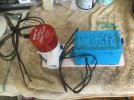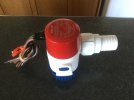- Joined
- May 6, 2014
- Messages
- 189
- Reaction score
- 2
- Points
- 18
I have a quick question. Last time I was at the coast my aft Bilge pump quit. I know its a Rule 1500 an will order another one but is the strainer basket mounted to the floor and you unsnap the old an snap in the new & wire?
Sorry I hate not being able to look myself. any help or photos would be great....
Thanks
Sorry I hate not being able to look myself. any help or photos would be great....
Thanks



